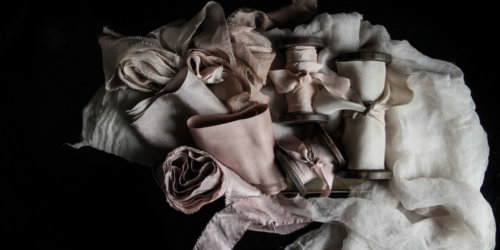
From Hibiscus to Avocado Pits, Plant Dyes are Everywhere
In Search of a Greener New York is an ongoing Garden Collage series of explorations about sustainability efforts in New York City and beyond– including the people, places, and ideas that are making Manhattan a healthier, happier place to live. In this column, we spotlight individuals who are making New York a “greener” place in an attempt to discover how, exactly, they are doing it. This week, GC spotlights Shellie Pomeroy, whose plant-dyed fabrics are a must-have for nature-loving brides.
Shellie Pomeroy, the mind behind Hudson Valley-based Silk and Willow, has one of the most enviable Instagrams out there. Each photo is its own sprawling Romantic still life, conjuring a slightly wild, mercurial mood. The images often pair handfuls of flowers and rich, rough wood with Pomeroy’s wares: plant-dyed silks and ribbons, as well as natural twines and papers. There is faint aura of mysticism about her work, as if they might be found on a conjurer’s cabinet; Pomeroy cultivates this ambiance by describing her dye process as its own field of specialized alchemy. As one would expect, the slightly enigmatic allure of her craft makes her highly sought-after for nature-based, bespoke weddings.
Below we caught up on how Pomeroy got into plant dyes in the first place, how she balances work with life, and her favorite plant for dyeing (yes, we made her pick!).
On how she got to where she is: “When my daughters were toddlers I was introduced to Waldorf education. I was inspired by their philosophy of teaching children to be ‘advocates for the environment’. After my first stroll through a Waldorf school nursery room with plant-dyed silks draped throughout the room, I was enchanted by the colors and textures. For many years after, my girls and I played with food as a dye for wool and silks. It wasn’t until years later that I dove deeper into the chemistry.”
On her favorite plants to dye with (for the record, she didn’t want to have to pick): “Avocado pits and the unexpected pink tone they create are quite amazing! Walnuts, abundant in my area, are one of my largest harvests. I just love the range in tones– from a soft ivory to a rich chocolate brown– that can be achieved from the walnut husks.”
On getting down in the dirt: “Gardening is my ‘play time’. Just getting my hands (and feet) in the dirt is therapeutic. This year I added more medicinal herbs to my garden; I am a little obsessed with them at the moment! It never ceases to amaze me how many plants can be used for both healing and creating dye color. Calendula, chamomile, hollyhock, and hibiscus… While risky for their invasive properties, this year I’ve also started [cultivating] some ‘weeds’ from seeds, including pokeweed, meadowsweet, and joe pye weed. I am eager to watch them grow and be harvested for dyeing. Aside from my dye plants, I love growing a collection of cutting flowers; my dearest being my peony flowers and Baptisia.”
On how dyeing plants is more than a job: “For me, dyeing with plants is a meditative practice. Years ago I formally studied meditation and became certified in Reiki. I feel these studies have given me an appreciation for patience and intention. When I am dyeing, I am most often alone for the process. I look forward to this quiet time where I can focus my intentions on the preparation and process of watching colors unfold.”
On her go-to spot in the Hudson Valley: “My current favorite local spot is Lagusta’s Luscious Commissary. Vegan chocolates, homemade nut milk, and healthy handmade meals. I wish I could eat there every day!”










































